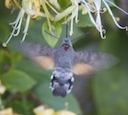 Hummingbird Hawk-moths are migratory visitors to The Lizard in good summers.
Hummingbird Hawk-moths are migratory visitors to The Lizard in good summers.
Photo: Ray Surridge
Scientific name: Macroglossum stellatarum
Cornish name: The general word for moth is ‘gouwan’
Conservation status: Not yet assessed by the IUCN
 Generally considered a summer migrant from warmer areas of Europe, Asia and northern Africa, the Hummingbird Hawk-moth flies during the day, usually in sunny weather but also at dusk and dawn. With a wingspan of 5 to 6 cm, its long proboscis, ability to hover and the humming sound as its wings beat have earned it its common name. This moth is specialised to feed on flowers with a tubular shape, such as honeysuckle. The black and white markings on its body are also very distinctive.
Generally considered a summer migrant from warmer areas of Europe, Asia and northern Africa, the Hummingbird Hawk-moth flies during the day, usually in sunny weather but also at dusk and dawn. With a wingspan of 5 to 6 cm, its long proboscis, ability to hover and the humming sound as its wings beat have earned it its common name. This moth is specialised to feed on flowers with a tubular shape, such as honeysuckle. The black and white markings on its body are also very distinctive.
The larval foodplants are Lady’s and Hedge Bedstraw and Wild Madder. Its caterpillars, which are green with cream/grey stripes after the first moult, are most likely to be spotted in August before pupating over the winter. In the UK, adults and pupae are unlikely to survive the winter.
Did you know…?
…Hummingbird Hawk-moths are good at learning to distinguish colours, helping them remember which plants were a good source of food.
…They are reported to be creatures of habit, returning to the same nectar source at a similar time from day to day.
…they need so much energy to sustain their fast wing beating, that they will feed and mate at the same time.
More information and references:
Kelber, A., 1996. Colour learning in the Hawkmoth Macroglossum stellatarum. The Journal of Experimental Biology, 199: 1127−1131.
Sterry, P. and Mackay, A., 2004. Pocket Nature: Butterflies and Moths. Dorling Kindersley, London.
Published: July 2013
Author: Amanda Scott
Photos: Ray Surridge
